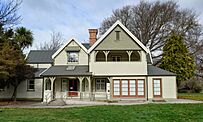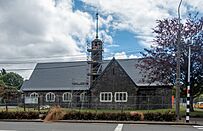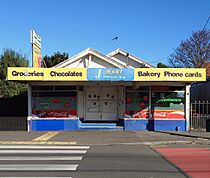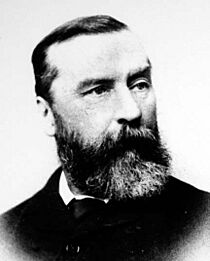Opawa facts for kids
Quick facts for kids
Opawa
|
|
|---|---|
|
Suburb
|
|
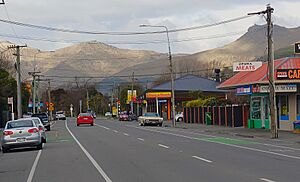
Main retail area on Opawa Road, looking south-east towards Mount Cavendish
|
|
| Country | New Zealand |
| Local authority | Christchurch |
| Electoral ward | Heathcote |
| Area | |
| • Land | 81 ha (200 acre) |
| Population
(June 2023)
|
|
| • Total | 1,320 |
|
|
||
Opawa is a suburb located inside the city of Christchurch, New Zealand. It's about 3.5 kilometers south-east of the city center. Opawa was once a low-lying area, like a continuation of the Sydenham swamp. In the 1860s, a few European settlers started living there. It then became a farming area, mostly settled by people from England.
As Woolston became a busy industrial area nearby, Opawa grew quickly. It changed into a fancy residential area. Many factory workers and businesspeople moved there. Famous historic buildings in Opawa include "Risingholme" and "The Hollies." Opawa used to be a part of the Heathcote County Council. It officially joined the city of Christchurch in 1916.
The Māori name for this area is Ōpāwaho. The original Māori settlement was called Poho-Areare. It was located near where Vincent Place and Judge Street meet today. This spot was important for controlling river travel on the Heathcote River. Today, the main roads in Opawa are Opawa Road and Ensors Road. The main shops are found along Opawa Road. State Highway 76 and the Main South Line railway are just north of the suburb.
Opawa is part of the Christchurch Central area for national elections. For local elections, it's part of the Heathcote Ward. The suburb has three primary schools, two kindergartens, a retirement village, and a rest home. It's also home to the Opawa Bowling Club and the Opawa Lawn Tennis Club. Many famous people have connections to Opawa, including early settlers and those born or educated there.
Contents
A Look Back: Opawa's History
The Māori name for this area is Ōpāwaho. It means 'Ō' (a part of) and 'pā' (a fortified village) and 'waho' (outer or outside). Ōpāwaho is also the name for the lower part of the Heathcote River. A kāinga (Māori settlement) was located near where Vincent Place and Judge Street are now. It was a resting place for Māori traveling between Kaiapoi Pā and the Banks Peninsula.
Māori living here used the nearby swamplands and the river. They caught lamprey and eels for food. The village itself was called Poho-Areare. This was also the name of an early rangatira (chief) of the settlement. The name also refers to a walking track from the village to South New Brighton. Later, Tūrakipō was the chief of the settlement.
Opawa was a low-lying area, connected to the Sydenham swamp. The Māori name for these swampy lands was Te Kuru. Poho-areare was a key location. It helped control river travel to the estuary and the ocean. Over time, the area became known as Ōpāwaho, and then officially Opawa.
By the 1860s, few European settlers lived here. The area south of Linwood and Woolston became a farming region. Early settlers in Opawa were farmers, mostly from England. Many came from wealthy families. In Opawa's early days, the center of the area was reportedly the corner of Locarno Street and Opawa Road. This is where St Mark's Anglican Church is located. Opawa grew around a bend in the Heathcote River. Many large houses were built on big properties along the river.
As Woolston became a busy industrial center, Opawa's population grew fast. It turned into a fancy residential area. People who couldn't find homes in Woolston, including factory workers and businesspeople, moved to Opawa. The suburb was damaged in the 2010 Canterbury earthquake. Some shops on Opawa Road had to close, and many homes were damaged by falling chimneys. The Opawa Library and Children's Library were also damaged. The Children's Library reopened, and the main Opawa Library was rebuilt in 2019.
Opawa's Location and Features
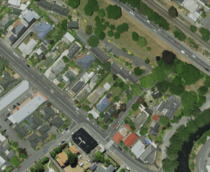
The Rāpaki Track, an old Māori walking path, is nearby. It goes through St Martins Valley, connecting the Canterbury Plains to Rāpaki and Lyttleton Harbour. Today, State Highway 76 (Brougham Street) and the Main South Line railway run through the northern part of the suburb. Other nearby suburbs include Murray Aynsley Hill, Huntsbury, St Martins, Waltham, Hillsborough, and Linwood.
The flat area between Opawa and Heathcote Valley has many industrial businesses. The main roads in Opawa are Opawa Road and Ensors Road. The main shopping area is on Opawa Road. It grew along one of the oldest routes, at the intersection of Hawford and Reeves Roads.
In 1967, there were plans for an "Opawa Expressway." This new road would have affected many homes and businesses. The plan was to build it alongside the railway line. This project would have caused a lot of disruption. Opawa Road is no longer the main road to Lyttelton and Heathcote.
The area between Brougham Street and Moorhouse Avenue, which includes Waltham and Sydenham, has many small businesses and light industrial buildings. The Main South Line railway used to serve the Addington Railway Workshops, one of Christchurch's biggest industries. Woolston also became an industrial center because it was on the railway line. The railways helped new settlements grow beyond the original suburbs. In Opawa, residents had frequent trains to Christchurch every day. Opawa is mostly residential, but it has a small shopping area on Opawa Road.
Opawa is a suburb that often experiences floods. Because it's next to the Heathcote River, the area has flooded many times recently.
The main road for transport in the area is State Highway 76 (Brougham Street). It goes through the northern part of the suburb, and also through Sydenham and Hillsborough. This road then connects to Port Hills Road and Tunnel Road, leading to the Lyttelton road tunnel at Heathcote Valley.
Important Landmarks in Opawa
Opawa has several important landmarks. Many are linked to the early European settlers in the area.
Risingholme
Risingholme was built in 1864 by Mary and William Reeves. It was owned by private families until 1943. Then, a kind person named John McKenzie bought it. He gave the building to the city council for "the health, amusement and instruction of the public." In 1944, it became one of New Zealand's first community centres. It is listed as a Category 2 historic place by Heritage New Zealand.
Fownhope
"Fownhope" was built in 1868. It's important because of its connection to Edward Harley, an English settler and accountant, and Frederick Bowler. The house is made from mataī and other native New Zealand trees. The floor is made of baltic pine, which came from Europe. Fownhope shows what many early European houses in the area looked like. It's a Category 2 historic place.
The Hollies
The Hollies was built in 1871. It's an old colonial house built by Edward Richardson, an English mechanic. Richardson was in charge of finishing the Lyttelton rail tunnel. He was born in England and trained as a civil engineer before moving to Christchurch. The building is close to the Heathcote River. The Hollies is also a Category 2 heritage-listed building.
St Mark's Anglican Church
St Mark's Anglican Church is on Opawa Road. Its first stone was laid in May 1865 by Bishop Selwyn. He was the first leader of the Anglican Church in New Zealand. In December 1949, the old St Mark's Anglican Church was destroyed by fire. This was a sad loss for many, as it was a link to Christchurch's early European settlers. A new church was built on the same spot and opened in December 1953.
Roxburghe
Roxburghe is located at 44 Opawa Road. Businessman William Wombwell Charters built it in 1879. The building is a great example of an Italianate villa. It was badly damaged during the 2010–2011 Canterbury earthquakes. New foundations were put in, and the building was repaired.
The Fifield
The Fifield, at 14 Hawford Road, is historically important. It's connected to civil engineer William Bray and pharmacist William Townend and his family. The building has a smoking room, a nursery, and servants' quarters. After the 2010–2011 Canterbury earthquakes, the house's chimneys were damaged. They partly collapsed and had to be removed.
9 Ford Road House
An unnamed house at 9 Ford Road is also a landmark. Famous residents included Otto and Margaret Frankel. This dwelling is historically important because of its connection to Austrian architect Ernst Plischke. It also shows how many European thinkers came to New Zealand in the 1930s to escape the growing influence of Nazism. Its modernist design also reflects important ideas. It has a Category 2 listing with Heritage New Zealand.
How Opawa is Governed
In its early days, Opawa was a "riding" (a local division) of the Heathcote County Council. In December 1915, people from Opawa asked the Christchurch City Council to join the city. More than 70 out of 210 ratepayers (people who pay local taxes) supported the idea. A spokesperson, J. Clarke, said the city could offer more services than the County Council. He also said homeowners were "quite willing to pay a little more in rates" for city services. George Scott, the chairman of Heathcote and a city councilor, supported the idea of the whole county joining Christchurch.
Opawa officially became part of Christchurch city in October 1916. Its neighbor, Woolston, remained a separate borough (a self-governing town) until it joined the city in November 1921. The Christchurch City Council now manages Opawa. The suburb is part of the Heathcote Ward for local elections. The current city councilor is Sara Templeton. For national elections, Opawa is part of the Christchurch Central area. The Member of Parliament is Duncan Webb from the Labour Party.
Who Lives in Opawa: Demographics
Opawa covers about 0.81 square kilometers. It has an estimated population of 1,320 people as of June 2023, . This means there are about 1630 people per square kilometer.
| Historical population | ||
|---|---|---|
| Year | Pop. | ±% p.a. |
| 2006 | 1,434 | — |
| 2013 | 1,302 | −1.37% |
| 2018 | 1,365 | +0.95% |
At the 2018 New Zealand census, Opawa had 1,365 people. This was an increase of 63 people (4.8%) since the 2013 census. There were 504 households, with 642 males and 723 females. The average age was 47.5 years. About 16% of the people were under 15 years old.
Most people in Opawa (90.8%) are European/Pākehā. Other groups include Māori (6.6%), Pasifika (1.3%), and Asian (5.1%). About 21.3% of people were born overseas.
When asked about religion, 52.7% said they had no religion. About 37.8% were Christian. Other religions included Hindu (0.9%) and Buddhist (1.1%).
About 31.7% of people aged 15 or older had a university degree or higher. The average income was $33,300. Many early residents of Opawa were businesspeople and factory workers. They moved here because they couldn't find homes in Woolston.
Learning in Opawa: Education
Opawa does not have any secondary schools (high schools). However, it has three primary schools and two kindergartens.
Opawa School
Opawa School (Te Kura o Ōpāwaho) is one of the oldest schools in North Canterbury. It's located on Ford Road. A new school building was started in 1920. Today, Opawa School teaches students from Year 1 to Year 8. It has about 313 students. The school first opened in 1872.
Kindergartens
There are two kindergartens in Opawa. One is on Cholmondeley Avenue, and the other is on Butler Street.
Christchurch Rudolf Steiner School
Christchurch Rudolf Steiner School is a state-integrated school. This means it's a private school that gets some government funding. It teaches students from Year 1 to Year 13. The school is on Ombersley Terrace and has about 328 students. It opened in 1975 and became state-integrated in 1989.
St Mark's School
St Mark's School is an Anglican state-integrated primary school. It teaches students from Year 1 to Year 8. It's located on Cholmondeley Avenue and has about 218 students. This school was started in 1921.
The closest secondary school is Te Aratai College (formerly Linwood College) in Phillipstown. It's about 2.5 kilometers north of Opawa. All these schools teach both boys and girls. Student numbers are as of February 2024. .
Fun and Facilities: Amenities
Opawa is home to the Opawa Bowling Club and the Opawa Lawn Tennis Club. The Opawa Bowling Club celebrated its 50th anniversary in March 1958. The Alpine Ice Centre is nearby on Brougham Street. It's Christchurch's main place for ice sports. It's where the Canterbury Red Devils ice hockey team plays.
The suburb is about 3.7 kilometers from Lancaster Park. This used to be Christchurch's main sports venue. Now, it's a public park with facilities for community sports. Recreational parks in Opawa include Risingholme Park and Hansens Park.
Hansens Park is a very notable park in Opawa. It used to be a rubbish dump. In 1959, there were plans to turn it into a park. Hansens Park has the clubrooms for the Port Hills Athletic Club. There are also two rugby fields and two football fields in the park.
Local businesses in Opawa include a café, a bakery, a butchery, a dairy (corner shop), a pharmacy, and an op-shop (second-hand store). More shops are also located on Ferry Road, about 2 kilometers north in Woolston. Opawa also has a retirement village and a rest home. Besides St Mark's Anglican Church, there's also the Opawa Community Church. It's on the corner of Opawa Road and Aynsley Terrace.
People from Opawa: Notable Residents
Many famous people have connections to Opawa. Some were born there, and others were early settlers in the suburb.
- Noeline Baker (1878–1958), an important person for women's work during wartime and an educator, was born in Opawa.
- Alfred William Buxton (1872–1950), a landscape gardener.
- John B. Condliffe (1891–1981), an economist and university professor, went to Opawa School.
- Margaret Frankel (1902–1997), a painter and art teacher.
- Otto Frankel (1900–1998), an Austrian-born geneticist.
- Kennaway Henderson (1879–1960), an illustrator and cartoonist.
- Ivan Mauger (1939–2018), a famous motorcycle speedway rider, went to Opawa School.
- Robert Page (1897–1957), an industrial chemist.
- William Reeves (1823–1891), a businessman and politician. He built and lived in "Risingholme" in 1864.
- William Pember Reeves (1857–1932), a politician, cricketer, and historian.
- Mollie Tripe (1870–1939), an artist and art teacher, was born in Opawa.
- Joshua Strange Williams (1837–1915), a politician and judge, was an early settler in Opawa.
- Wilfred Stanley Wallis (1891–1957), an orthopaedic surgeon, was born in Opawa.
- Anthony Wilding (1883–1915), one of New Zealand's most successful tennis players, was born in Opawa.
- Robin Williams (1919–2013), an academic and mathematician.




